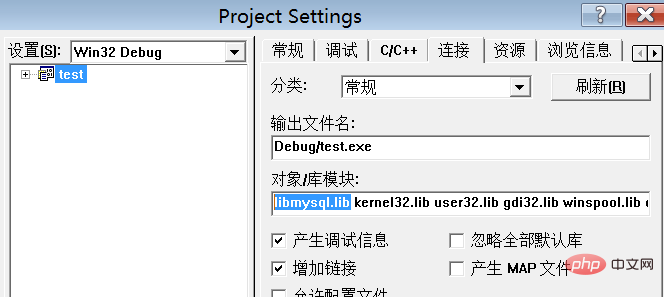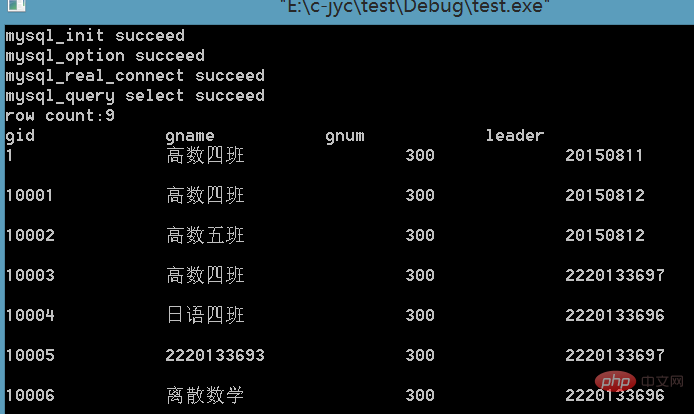How to connect vc to mysql database
How to connect vc to mysql database: first open VC6; then add the include directory path of the locally installed MySQL in the middle list box; then select "Library files" and add the Lib directory path of MySQL; finally perform programming testing That’s it.

Recommended: "mysql video tutorial"
1. MySQL installation
To install MySQL, just go to the official website and download it. . . The latest is version 5.7. .
2. VC6.0 settings
(1) Open VC6. Select 0 Options under the Tools menu of the toolbar , click "Includefiles" in the "Show directories for:" drop-down list on the right side of the Directories tab, and then add the include directory path of your locally installed MySQL in the middle list box. As shown in the picture:

(2) In the "Show directories for:" drop-down list mentioned above Select "Library files" and then add the Lib directory path to your local MySQL installation. As shown in the picture:

**I would like to explain here: careful people will find that my directory is different from the previous picture. Same, this is because of this error: libmysql.lib: fatal error LNK1113: invalid machine Invalid server
This is because vc develops a 32-bit program , and the MySQL database is caused by 64-bit. If you use a 32-bit program to operate a 64-bit database, you will definitely make an error. I will explain in detail how to solve it in the next blog post.
(3) Add "libmysql.lib" in "Project settings->Link:Object/library modules".

(5) It is recommended to copy "libmySQL.lib, libmySQL.dll" to the directory of the project you built.
These two files are in the D:\Mysql\lib directory.
3. Programming implementation
1. A simple small program to see if the connection can be successful. . .
#include <stdio.h>
#include <windows.h>
#include <mysql.h>
int main()
{
MYSQL mysql;
mysql_init(&mysql); //初始化mysql结构
if(!mysql_real_connect(&mysql,"localhost","myuser","123456","student_db",3306,NULL,0))
printf("\n连接数据库时发生错误!\n");
else
printf("\n连接数据库成功!\n");
mysql_close(&mysql); //释放数据库
return 0;
}mysql_real_connect(&mysql,"localhost","myuser","123456","student_db",3306,NULL,0)//myuser is my user name, "123456" is the password , "student_db" is the database, 3306 is the port number
2. Implement the query applet
// test.cpp : Defines the entry point for the console application.
//
#include <stdio.h>
#include <windows.h>
#include "StdAfx.h"
#include <winsock.h>
#include <iostream>
#include <string>
#include <mysql.h>
using namespace std;
//不需要单步调试的就注释掉
//#define STEPBYSTEP
void pause(){
#ifdef STEPBYSTEP
system("pause");
#endif
}
void writeToFile(const char *s)
{
FILE *fp=fopen("info.txt","rw");
fprintf(fp,s);
fclose(fp);
}
/* int main()
{
MYSQL mysql;
mysql_init(&mysql); //初始化mysql结构
if(!mysql_real_connect(&mysql,"localhost","myuser","123456","student_db",3306,NULL,0))
printf("\n连接数据库时发生错误!\n");
else
printf("\n连接数据库成功!\n");
mysql_close(&mysql); //释放数据库
return 0;
}*/
int main(int argc, char* argv[]){
cout<<"start...."<<endl;
pause();
MYSQL mysql;
if(0==mysql_library_init(0,NULL,NULL))
{
cout<<"mysql_library_init succeed"<<endl;
}else{
cout<<"mysql_library_init failed"<<endl;
return -1;
}
pause();
if(NULL!=mysql_init(&mysql))
{
cout<<"mysql_init succeed"<<endl;
}else{
cout<<"mysql_init failed"<<endl;
return -1;
}
pause();
if(0==mysql_options(&mysql,MYSQL_SET_CHARSET_NAME,"gb2312"))
{
cout<<"mysql_option succeed"<<endl;
}else{
cout<<"mysql_option failed"<<endl;
return -1;
}
pause();
if(NULL!=mysql_real_connect(&mysql,"localhost","myuser","123456","student_db",3306,NULL,0))
{
cout<<"mysql_real_connect succeed"<<endl;
}else{
cout<<"mysql_real_connect failed"<<endl;
return -1;
}
pause();
string sql;
sql="select * from sgroup";
MYSQL_RES *result=NULL;
if(0==mysql_query(&mysql,sql.c_str()))
{
cout<<"mysql_query select succeed"<<endl;
result=mysql_store_result(&mysql);
int rowcount=mysql_num_rows(result);
cout<<"row count:"<<rowcount<<endl;
unsigned int fieldcount=mysql_num_fields(result);
MYSQL_FIELD *field=NULL;
for(unsigned int i=0;i<fieldcount;i++)
{
field=mysql_fetch_field_direct(result,i);
cout<<field->name<<"\t\t";
}
cout<<endl;
MYSQL_ROW row=NULL;
row=mysql_fetch_row(result);
while(NULL!=row)
{
for(int i=0;i<fieldcount;i++){
cout<<row[i]<<"\t\t";
}
cout<<endl;
row=mysql_fetch_row(result);
}
}else{
cout<<"mysql_query select data failed"<<endl;
mysql_close(&mysql);
return -1;
}
pause();
/*sql="drop table user_info";
if(0==mysql_query(&mysql,sql.c_str()))
{
cout<<"mysql_query drop table succeed"<<endl;
}else{
cout<<"mysql_query drop table failed"<<endl;
mysql_close(&mysql);
return -1;
} */
mysql_free_result(result);
mysql_close(&mysql);
mysql_server_end();
system("pause");
return 0;
}Running results:

The connection is successful. . Ha ha. .
The above is the detailed content of How to connect vc to mysql database. For more information, please follow other related articles on the PHP Chinese website!

Hot AI Tools

Undresser.AI Undress
AI-powered app for creating realistic nude photos

AI Clothes Remover
Online AI tool for removing clothes from photos.

Undress AI Tool
Undress images for free

Clothoff.io
AI clothes remover

Video Face Swap
Swap faces in any video effortlessly with our completely free AI face swap tool!

Hot Article

Hot Tools

Notepad++7.3.1
Easy-to-use and free code editor

SublimeText3 Chinese version
Chinese version, very easy to use

Zend Studio 13.0.1
Powerful PHP integrated development environment

Dreamweaver CS6
Visual web development tools

SublimeText3 Mac version
God-level code editing software (SublimeText3)

Hot Topics
 1386
1386
 52
52
 MySQL: Simple Concepts for Easy Learning
Apr 10, 2025 am 09:29 AM
MySQL: Simple Concepts for Easy Learning
Apr 10, 2025 am 09:29 AM
MySQL is an open source relational database management system. 1) Create database and tables: Use the CREATEDATABASE and CREATETABLE commands. 2) Basic operations: INSERT, UPDATE, DELETE and SELECT. 3) Advanced operations: JOIN, subquery and transaction processing. 4) Debugging skills: Check syntax, data type and permissions. 5) Optimization suggestions: Use indexes, avoid SELECT* and use transactions.
 How to open phpmyadmin
Apr 10, 2025 pm 10:51 PM
How to open phpmyadmin
Apr 10, 2025 pm 10:51 PM
You can open phpMyAdmin through the following steps: 1. Log in to the website control panel; 2. Find and click the phpMyAdmin icon; 3. Enter MySQL credentials; 4. Click "Login".
 MySQL: An Introduction to the World's Most Popular Database
Apr 12, 2025 am 12:18 AM
MySQL: An Introduction to the World's Most Popular Database
Apr 12, 2025 am 12:18 AM
MySQL is an open source relational database management system, mainly used to store and retrieve data quickly and reliably. Its working principle includes client requests, query resolution, execution of queries and return results. Examples of usage include creating tables, inserting and querying data, and advanced features such as JOIN operations. Common errors involve SQL syntax, data types, and permissions, and optimization suggestions include the use of indexes, optimized queries, and partitioning of tables.
 How to use single threaded redis
Apr 10, 2025 pm 07:12 PM
How to use single threaded redis
Apr 10, 2025 pm 07:12 PM
Redis uses a single threaded architecture to provide high performance, simplicity, and consistency. It utilizes I/O multiplexing, event loops, non-blocking I/O, and shared memory to improve concurrency, but with limitations of concurrency limitations, single point of failure, and unsuitable for write-intensive workloads.
 Why Use MySQL? Benefits and Advantages
Apr 12, 2025 am 12:17 AM
Why Use MySQL? Benefits and Advantages
Apr 12, 2025 am 12:17 AM
MySQL is chosen for its performance, reliability, ease of use, and community support. 1.MySQL provides efficient data storage and retrieval functions, supporting multiple data types and advanced query operations. 2. Adopt client-server architecture and multiple storage engines to support transaction and query optimization. 3. Easy to use, supports a variety of operating systems and programming languages. 4. Have strong community support and provide rich resources and solutions.
 MySQL's Place: Databases and Programming
Apr 13, 2025 am 12:18 AM
MySQL's Place: Databases and Programming
Apr 13, 2025 am 12:18 AM
MySQL's position in databases and programming is very important. It is an open source relational database management system that is widely used in various application scenarios. 1) MySQL provides efficient data storage, organization and retrieval functions, supporting Web, mobile and enterprise-level systems. 2) It uses a client-server architecture, supports multiple storage engines and index optimization. 3) Basic usages include creating tables and inserting data, and advanced usages involve multi-table JOINs and complex queries. 4) Frequently asked questions such as SQL syntax errors and performance issues can be debugged through the EXPLAIN command and slow query log. 5) Performance optimization methods include rational use of indexes, optimized query and use of caches. Best practices include using transactions and PreparedStatemen
 MySQL and SQL: Essential Skills for Developers
Apr 10, 2025 am 09:30 AM
MySQL and SQL: Essential Skills for Developers
Apr 10, 2025 am 09:30 AM
MySQL and SQL are essential skills for developers. 1.MySQL is an open source relational database management system, and SQL is the standard language used to manage and operate databases. 2.MySQL supports multiple storage engines through efficient data storage and retrieval functions, and SQL completes complex data operations through simple statements. 3. Examples of usage include basic queries and advanced queries, such as filtering and sorting by condition. 4. Common errors include syntax errors and performance issues, which can be optimized by checking SQL statements and using EXPLAIN commands. 5. Performance optimization techniques include using indexes, avoiding full table scanning, optimizing JOIN operations and improving code readability.
 Monitor Redis Droplet with Redis Exporter Service
Apr 10, 2025 pm 01:36 PM
Monitor Redis Droplet with Redis Exporter Service
Apr 10, 2025 pm 01:36 PM
Effective monitoring of Redis databases is critical to maintaining optimal performance, identifying potential bottlenecks, and ensuring overall system reliability. Redis Exporter Service is a powerful utility designed to monitor Redis databases using Prometheus. This tutorial will guide you through the complete setup and configuration of Redis Exporter Service, ensuring you seamlessly build monitoring solutions. By studying this tutorial, you will achieve fully operational monitoring settings




